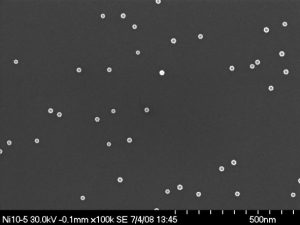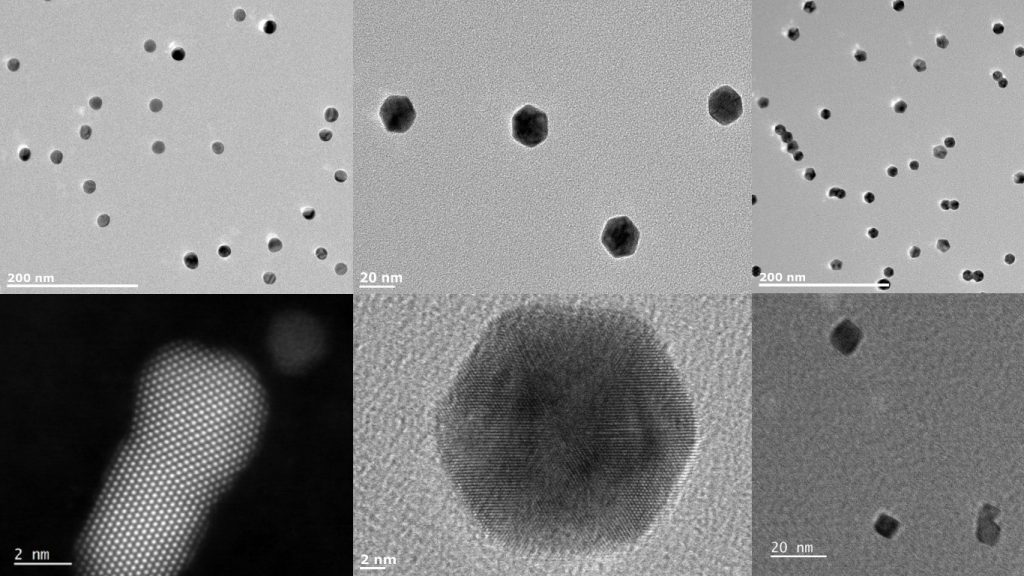Magnetic nanoparticles are a major class of nanomaterials that offer unique advantages in MRI diagnostics. This blog post covers the fundamentals of magnetic nanoparticles and sees how they’re enabling more accurate medical diagnoses.
What are magnetic nanoparticles?
Many people are familiar with the idea that materials have certain properties that are independent of size, such as stiffness, thermal conductivity and electrical resistivity. Nanoparticles put this idea to the test.
One of the defining characteristics of nanoparticles (pieces of material between around 1 and 100 nanometers in diameter) is that being very small makes them behave strangely. The properties of a copper nanoparticle, for example, are remarkably different from the properties of bulk copper that we may be accustomed to in our day-to-day “macroscale” world – and these properties are often very strongly dependent on a nanoparticle’s size.
Many of these “strange” properties are a result of the fact that very small particles have very high surface-area-to-volume ratios, which means that surface effects tend to dominate over bulk effects. For example, nanoparticles tend to have very high solvent affinities that enable them to form suspensions in water, and they also tend to exhibit radically different mechanical properties from bulk solids.
Other interesting properties arise from the confinement of subatomic particles such as electrons, protons and photons with nanoparticles: these include surface plasmon resonance in some metals and quantized electronic energy levels in semiconductor nanoparticles below 10 nm in diameter.
Perhaps unsurprisingly, magnetic nanoparticles (those made from magnetic materials) exhibit their own unique behavior, particularly a phenomenon known as superparamagnetism. This particular quirk of magnetism means that magnetic nanoparticles can perform an invaluable role as contrast agents in MRI applications. Magnetic nanoparticles also have a range of other potential applications in biomedicine, catalysis and sensing.
Properties of Magnetic Nanoparticles
Bulk ferromagnetic materials such as iron are typically divided into magnetic “domains” – groupings of atoms that share the same magnetic alignment.1 These domains are magnetically susceptible, meaning an external magnetic field can “flip” the orientation of domains and cause them to line up with each other. This magnetization will persist until the material is heated to its Curie temperature – usually hundreds of degrees centigrade (770 C in iron).
Producing magnetic nanoparticles from ferromagnetic materials causes a few changes. Firstly, because magnetic nanoparticles are so small, a single magnetic nanoparticle will constitute a single magnetic domain – this means that there can be no magnetic ordering within a sample of magnetic nanoparticles. Secondly, decreasing the volume of a magnetic nanoparticle effectively decreases its Curie temperature.2,3 In sufficiently small magnetic nanoparticles, thermal energy at room temperature is sufficient to flip their magnetization spontaneously.
The results in magnetic nanoparticles can exhibit superparamagnetism. The nanoparticles exhibit high susceptibility to external magnetic fields, but magnetic nanoparticles do not retain this magnetization once the field is removed, unlike macroscale magnets.
Using Magnetic Nanoparticles in MRI
MRI (magnetic resonance imaging) is a medical imaging technique that magnetizes atomic nuclei in the body and measuring the “relaxation time” required for them to reorient themselves
Magnetic nanoparticles, especially ones made from iron oxide, make excellent MRI contrast agents.4,5 This is thanks not only to their unique magnetic properties but also to the fact that they offer excellent biocompatibility and biodegradability and can be tailored to specific types of tissue within the body. Functionalizing magnetic nanoparticles with ligands such as sugars, antibodies or short peptide chains enables them to preferentially bind to certain tissues or structures within the body. Bound magnetic nanoparticles can be easily detected via MRI, enabling these structures to be imaged in much greater detail than would otherwise be possible.

As a result, magnetic nanoparticles are currently undergoing development and application for improved diagnosis of a wide range of diseases, including cancer, cardiovascular disease and neurological disease.
Nanoparticles from Nikalyte
Nikalyte deposition equipment can generate high-quality nanoparticles from a wide range of materials, including iron, iron oxide, nickel and nickel oxide. We also offer a consultancy service, enabling our customers to take advantage of our 20+ years of expertise in nanoparticle technology. Get in touch with us today to find out more about our services and solutions.

References and Further Reading
- Nondestructive Evaluation Physics : Magnetism. https://www.nde-ed.org/Physics/Magnetism/MagneticMatls.xhtml.
- Mcnerny, K., Kim, Y., Laughlin, D. & McHenry, M. Chemical synthesis of monodisperse γ-Fe–Ni magnetic nanoparticles with tunable Curie temperatures for self-regulated hyperthermia. Journal of Applied Physics 107, 09A312-09A312 (2010).
- Colossal Reduction in Curie Temperature Due to Finite-Size Effects in CoFe2O4 Nanoparticles | Chemistry of Materials. https://pubs.acs.org/doi/10.1021/cm301927z.
- Avasthi, A., Caro, C., Pozo-Torres, E., Leal, M. P. & García-Martín, M. L. Magnetic Nanoparticles as MRI Contrast Agents. Top Curr Chem (Z) 378, 40 (2020).
- Rümenapp, C., Gleich, B. & Haase, A. Magnetic Nanoparticles in Magnetic Resonance Imaging and Diagnostics. Pharmaceutical research 29, 1165–79 (2012).

